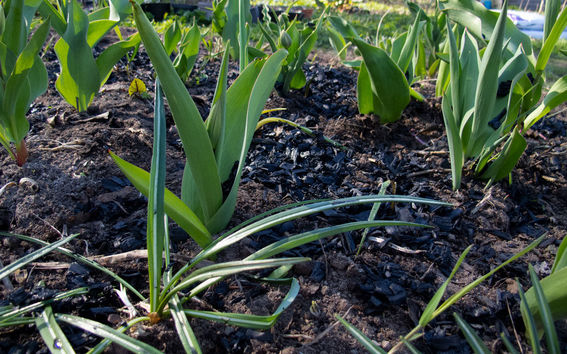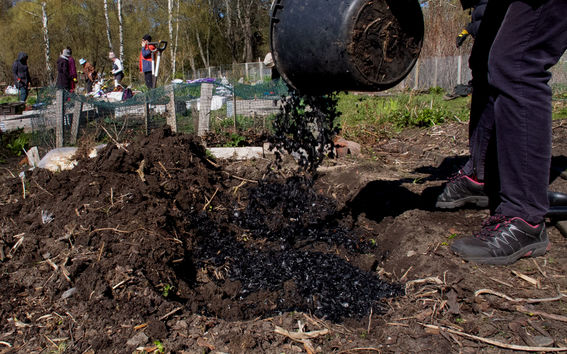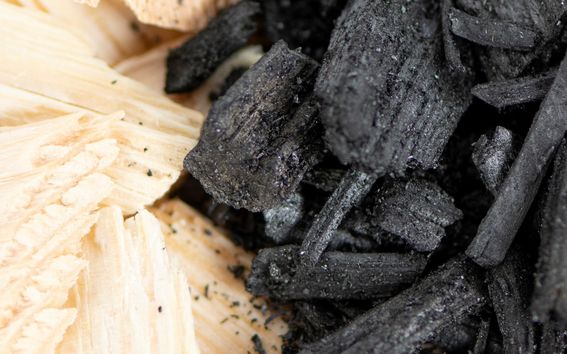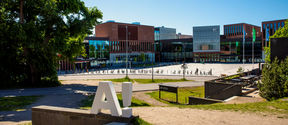Biochar is a step towards a more lush and sustainable city

The City of Helsinki explores increasing the use of biochar on selected demonstration sites across its public green structures. Biochar planting can help grow plants in challenging growing conditions such as roadsides and rooftop gardens. Biochar absorbs water and nutrients, helping to adapt to extreme weather conditions such as heavy rainfall and drought.
Mikko Jalas, Professor in the field of Co-innovating for Circular Solutions at the School of Arts, Design and Architecture has been involved in the Helsinki biochar project since 2018.
"Charcoal does not decompose and thus emit greenhouse gases. This also improves the growing conditions," says Jalas.
Biochar is porous and absorbs water. This can keep plants green, even when the weather turns dry. As the plants grow, more carbon dioxide is absorbed from the air. Experiments are underway to create biochar plantations along the Baana cycle route.


Biochar from garden waste by pyrolysis
Biochar is produced by pyrolysis. Pyrolysis, or dry distillation, is a chemical reaction in which organic solids are decomposed by heating without oxygen being allowed to enter the process. The municipal waste management service HSY pilot plant has pyrolysed grass cuttings, forestry stumps and cut lake stumps, for example. Biochar has also been tested in waste water treatment.
"It would be good to get Helsinki Energy Helen involved in the project, so that the heat from pyrolysis could be used as district heat," Jalas says.
The project will test different biomasses as potential raw materials for biochar production. The aim of the project is to spread awareness of the benefits of using biochar and to provide practical know-how on the use of biochar among city administrations and citizens.
What’s in it from a design point of view?
Why then is design needed for an agroecological project?
"From a design point of view, the project has two benefits," says Jalas. "The first is market creation. You have to get in tune with the material in order to sell it on to producers, users and the market in general. We need to test different pre-commercial uses of biochar products in practice and learn from the experiments."
Biochar has been used in urban agriculture in Sweden for many years. In Helsinki, for its part, it has been tried out on nine larger-scale sites, where various twists and turns have been overcome and lessons learned.
"Another aspect is making the project visible to the public. We try to get close to the citizens, for example by planting parcels of land and discussing biochar in citizen workshops. The biggest experiments in the project include growing grass on a football pitch with biochar or using it in the yard of Finlandia House. The project is not easily visible to outsiders because the proportion of carbon in the litter is only 5-10%.
"The project also needs people who can disseminate the method of cultivation and teach, for example, plot farmers how to use biochar. I think that biochar could be distributed to those who pay the household plot fee," says Jalas.
Jalas is pleased with the rapid progress of the project. At the end of the year, however, funding will be cut off and the way forward is open.
"I hope that we have achieved enough and that the project has continuity. All in all, we have received more sites than we expected at the beginning. The city has a clear will to use biochar, and we see that there are several overlapping benefits. Biochar is a step towards a comfortable, lush and socially sustainable city," says Jalas.
- Published:
- Updated:
Read more news

Seed funding available to boost collaboration between Aalto, KU Leuven and University of Helsinki
Aalto University, KU Leuven and the University of Helsinki launch the 2nd exploratory seed funding call to explore research collaboration possibilities. The funding call is open until 10 September 2024.
Professor Peter Hans Matthews works as a Fulbright-Aalto Distinguished Chair scholarship holder at the Department of Economics
Fulbright programmes and scholarships are highly appreciated in the United States
Aalto EE Introduces Alex: A New Learning Experience Platform to Transform Lifewide Learning and Tackle Upskilling Challenges
Aalto University Executive Education (Aalto EE) is launching the first version of Alex in June, a learning platform designed to enhance continuous professional development. Alex offers personalized learning journeys, micro-credentials, and professional development programs, aligning current skills with industry needs. This platform, which continuously evolves with new features like mobile access and AI integration, sets a new standard for professional development in Finland.